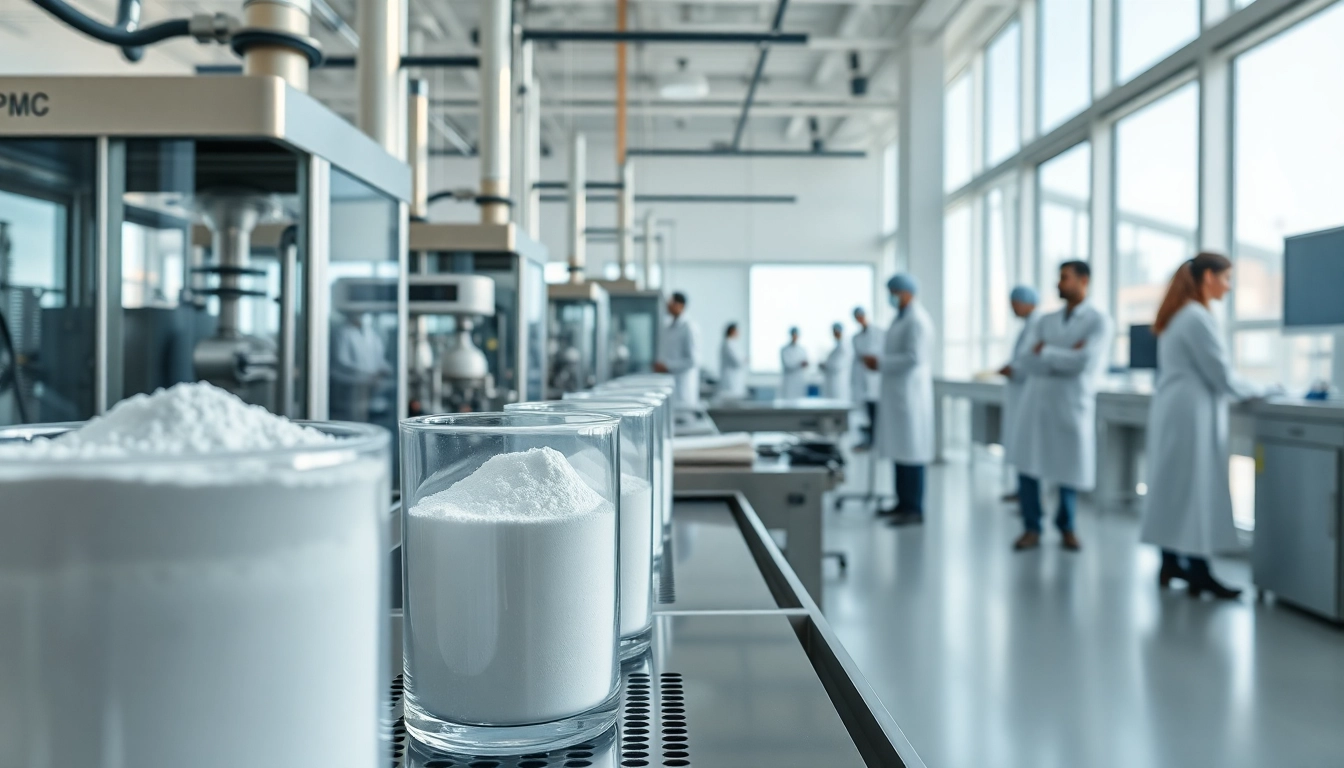
Boosting Quality and Efficiency: The Role of HPMC Manufacturer in Modern Industry
Introduction to HPMC Manufacturer
In the contemporary industrial landscape, Hydroxypropyl Methylcellulose (HPMC) has emerged as a vital compound, playing a significant role across various sectors, including construction, pharmaceuticals, and food. As businesses strive for quality and innovation, the demand for reliable and high-quality supplies has never been greater. Selecting the right HPMC manufacturer can profoundly influence product quality and business efficiency. This article delves into the essence of HPMC, its production processes, challenges, and the future of HPMC manufacturing. We aim to provide a comprehensive understanding, enabling companies to make informed decisions when sourcing this critical material.
What is HPMC?
Hydroxypropyl Methylcellulose (HPMC) is a semi-synthetic polymer derived from cellulose, a natural polymer obtained from plant fibers. The modification process involves the substitution of hydroxyl groups in cellulose with hydroxypropyl and methyl groups, allowing HPMC to exhibit unique properties. This makes HPMC a versatile ingredient widely used as an additive, binder, and thickening agent. Its primary characteristics include solubility in water, film-forming ability, and the capacity to improve texture and stability in various formulations.
Applications of HPMC in Various Industries
The versatility of HPMC translates into countless applications across diverse sectors. Here are some of the integral industries that utilize HPMC:
- Construction: HPMC is employed as a key component in tile adhesives, plasters, and mortars. It enhances workability, water retention, and adhesion properties, making it indispensable in modern construction.
- Pharmaceuticals: In the pharmaceutical industry, HPMC is used as a drug excipient, acting as a binder, thickener, and controlled-release agent in solid dosage forms.
- Food Industry: HPMC serves as a food additive that enhances texture and viscosity, commonly found in sauces, dressings, and bakery products, allowing for improved mouthfeel and stability.
- Cosmetics: HPMC is used in cosmetic formulations for its thickening and stabilizing properties, often found in lotions, creams, and gels.
Benefits of Using HPMC from a Quality Manufacturer
Choosing HPMC from a reputable manufacturer can significantly enhance product quality and performance. The advantages of sourcing HPMC from a reliable supplier include:
- Consistency and Reliability: High-quality HPMC ensures uniformity in application, resulting in stable formulations far more effective than those using inferior products.
- Enhanced Functionality: Quality HPMC improves the performance of end products, offering superior adhesion, moisture retention, and stabilization, which can be critical in applications like construction and pharmaceuticals.
- Regulatory Compliance: Reputable manufacturers adhere to stringent regulatory standards, providing products that conform to quality and safety requirements, which is essential for businesses aiming for compliance in their respective industries.
- Technical Support: Established manufacturers often provide valuable technical resources and expertise, assisting clients in optimizing their formulations and applications.
Understanding HPMC Production Processes
Raw Materials Used in HPMC Manufacturing
The production of HPMC involves specific raw materials, which primarily include cellulose, hydroxypropyl groups, and methyl groups. Cellulose serves as the base material, derived from wood pulp or cotton linters. The quality of these raw materials significantly impacts the final product’s properties, influencing characteristics such as viscosity, solubility, and film-forming ability. It is crucial for manufacturers to source high-quality cellulose to ensure the production of superior HPMC.
Step-by-Step Production Process of HPMC
The HPMC manufacturing process is intricate and involves several key steps:
- Preparation of Cellulose: The cellulose is purified to remove impurities that could affect the final product’s performance.
- Etherification: The purified cellulose is then treated with propylene oxide and methyl chloride, initiating the etherification process. This process replaces hydroxyl groups on the cellulose chain with hydroxypropyl and methyl groups.
- Neutralization: Following etherification, the resulting product is neutralized to stabilize the structure and prepare it for further processing.
- Drying and Milling: The neutralized HPMC is dried and milled into a fine powder, ensuring uniform particle size, which is crucial for its application properties.
- Quality Testing: Rigorous quality control tests are performed to assess the product’s viscosity, solubility, and purity before it reaches the market.
Quality Control Procedures in HPMC Manufacturing
Quality control is paramount in HPMC manufacturing to ensure that the final product meets specified standards. The quality control measures typically encompass:
- Raw Material Inspection: Each batch of raw materials is inspected for quality, ensuring compliance with specifications before processing.
- In-Process Testing: During production, regular testing is conducted to monitor viscosity and other critical parameters, enabling immediate corrective actions if deviations occur.
- Final Product Testing: The finished HPMC undergoes thorough testing, including assessments of water solubility, appearance, and particle size distribution. These tests ensure that the product is suitable for its intended applications.
Choosing the Right HPMC Manufacturer
Key Factors to Consider
Selecting the right HPMC manufacturer is a crucial decision that can impact the quality of your products and overall business operations. Here are some essential factors to consider during the selection process:
- Experience and Reputation: Look for manufacturers with a longstanding history and a strong reputation in the market. Experience often correlates with expertise and product reliability.
- Product Quality: Assess product specifications and certifications that demonstrate adherence to international quality standards.
- Customization Capabilities: A manufacturer’s ability to customize formulations based on specific needs can be a great advantage, ensuring that you receive products tailored to your applications.
- Customer Support: Consider a manufacturer that provides comprehensive customer support, which can include technical assistance, formulation advice, and responsive communication.
Comparing HPMC Manufacturers: What Sets Them Apart?
When comparing various HPMC manufacturers, certain distinguishing factors can guide your decision-making process. These include:
- Product Range: Some manufacturers may offer a broader range of HPMC grades and specializations, catering to distinct applications across industries.
- Technological Advancements: Manufacturers utilizing advanced technology in production processes often yield higher quality and more consistent products.
- Sustainability Practices: A manufacturer’s commitment to sustainable practices can be a significant selling point, as consumers increasingly prioritize environmental responsibility.
Finding Reliable Suppliers of HPMC
Finding a reliable HPMC supplier can be a daunting task. It’s essential to take a strategic approach by:
- Networking: Engage with industry peers and attend trade shows or conferences to gather recommendations and insights on reputable suppliers.
- Online Research: Leverage online platforms and directories that list certified HPMC manufacturers, providing valuable information about their offerings and reputation.
- Requesting Samples: Before making a bulk order, request samples from different manufacturers to evaluate product quality and functionality in your applications.
Challenges in HPMC Manufacturing
Common Issues Faced by HPMC Manufacturers
The HPMC manufacturing process is fraught with challenges that can affect product quality and consistency. Common issues include:
- Supplier Variability: Variability in raw material quality from suppliers can lead to inconsistencies in the final HPMC product.
- Process Control: Maintaining control over the manufacturing process is essential; even slight variations can have significant impacts on viscosity and solubility.
- Regulatory Compliance: Navigating the maze of regulatory requirements can be complex, posing a significant challenge for manufacturers aiming to market their products globally.
Strategies for Overcoming Production Challenges
To mitigate the challenges in HPMC manufacturing, companies can adopt various strategies:
- Supplier Quality Management: Establish strong relationships with reliable suppliers and implement strict quality control measures to ensure consistency in raw materials.
- Process Automation: Investing in automated systems can enhance process control, reducing the likelihood of human error and maintaining high product quality.
- Compliance Planning: Staying informed about regulatory changes and maintaining a robust compliance framework can help navigate the complexities associated with market entry.
Regulatory Compliance in HPMC Manufacturing
Regulatory compliance is of utmost importance in HPMC manufacturing to ensure safety and efficacy in use across different industries. Manufacturers must be aware of the regulations governing the production and distribution of HPMC, which may vary by country. Key regulatory considerations include:
- Certifications: Obtaining relevant certifications, such as ISO and GMP, can enhance the credibility of HPMC products.
- Ingredient Listing: Ensuring all ingredients meet regulatory standards and are appropriately listed on product labels is essential for consumer safety.
- Documentation: Maintaining thorough production documentation and quality control records is vital for compliance audits and regulatory inspections.
The Future of HPMC Manufacturing
Trends Influencing the HPMC Market
The HPMC market is experiencing dynamic changes influenced by various trends:
- Clean Label Demand: Consumers are increasingly seeking products with clean labels, prompting manufacturers to use HPMC with natural and non-GMO sources.
- Sustainable Practices: There is a growing emphasis on sustainable manufacturing processes, leading manufacturers to adopt eco-friendly practices and renewable raw material sourcing.
- Technological Advancements: Advances in production technologies, such as high-throughput manufacturing and advanced formulation techniques, are reshaping the industry.
Innovations in HPMC Production Techniques
Innovation is at the heart of HPMC manufacturing, driven by the need for enhanced product performance and reduced environmental impact. Notable innovations in HPMC production techniques include:
- Enzymatic Modification: Utilizing enzymes to modify cellulose can produce HPMC with tailored properties while minimizing chemical inputs.
- Continuous Production Processes: Transitioning from batch to continuous production systems can improve efficiency and reduce production costs.
- Advanced Characterization Methods: Implementing state-of-the-art characterization techniques allows for better understanding and control of product properties, leading to superior quality.
Long-Term Impact of HPMC Manufacturers on Industries
HPMC manufacturers play a pivotal role in shaping the future of multiple industries. By consistently delivering high-quality products, manufacturers can:
- Boost Innovation: Quality HPMC enables businesses to experiment with new formulations and applications, driving innovation across sectors.
- Enhance Product Performance: The reliability of HPMC leads to improved performance of end products, ensuring they meet consumer expectations.
- Support Sustainability Goals: HPMC manufacturers that prioritize eco-friendly practices contribute to the sustainability efforts of the industries they serve, aligning with global environmental goals.
